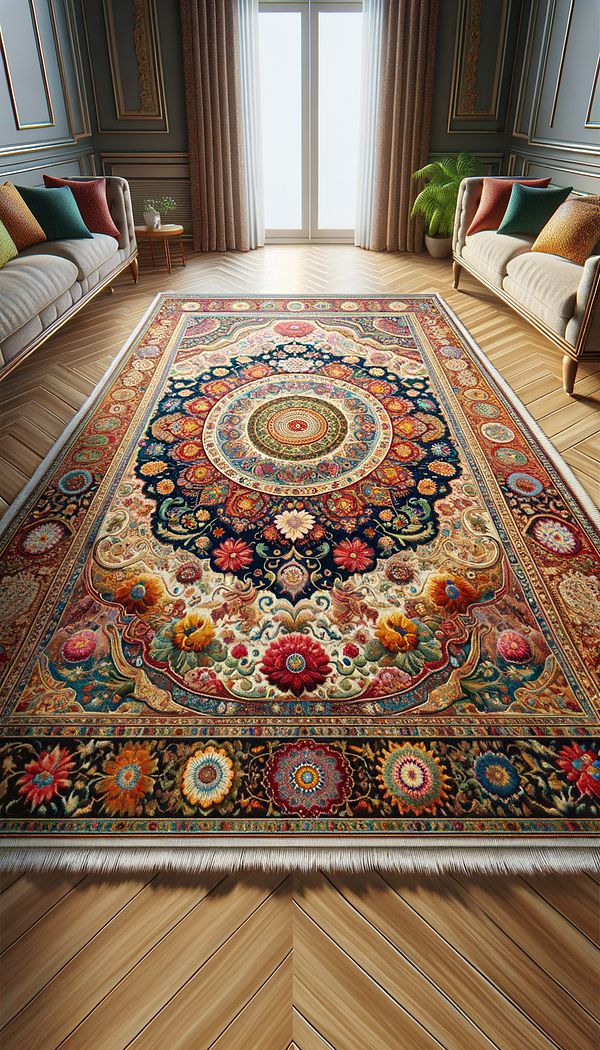What is Persian Rug?
A Persian rug is a handwoven carpet from Iran, known for its intricate designs and high quality.
Description
A Persian rug is a true masterpiece of craftsmanship, embodying centuries of culture, history, and artistry from Iran (formerly Persia). These rugs are distinguished by their elaborate designs, which can include floral patterns, animal figures, and intricate geometric shapes, meticulously woven into each piece. The beauty of a Persian rug lies not only in its visual appeal but also in the skill and time invested in its creation, typically handwoven using natural materials such as wool, cotton, and silk.
The techniques used in creating a Persian rug have been passed down through generations, with certain patterns and styles associated with specific regions of Iran. This geographical diversity within the tradition adds to the uniqueness and value of each rug. Persian rugs are also admired for their vibrant colors, achieved through the use of natural dyes, which contribute to their distinctive look. A high-quality Persian rug is not just a piece of home decor; it is considered a work of art and a valuable investment, often lasting for decades with proper care.
In contemporary interior design, Persian rugs can serve multiple roles, from being the focal point in a minimalist setting to complementing the aesthetic in traditional and eclectic designs. Their timeless allure means they can seamlessly integrate into various design styles, adding warmth, texture, and sophistication to any space.
Usage
Persian rugs are versatile in their application within interior design. They can be found adorning the floors of living rooms, bedrooms, dining areas, and even galleries. Due to their rich colors and elaborate patterns, Persian rugs can either act as a statement piece within a room or work harmoniously with other decorative elements to create a layered, textured look. In a minimalist interior, a Persian rug can add just the right amount of color and pattern to bring the space to life, while in a more traditional setting, it can enhance the room's elegance and historical charm.
FAQs
-
How can you tell if a Persian rug is authentic?
Authenticity can be determined by examining the quality of materials, knot density, craftsmanship, and the presence of a unique design that is characteristic of a specific region in Iran. Hand-knotted construction and natural dyes are also indicators of a genuine Persian rug.
-
How do you care for a Persian rug?
Proper care includes regular vacuuming, immediate stain treatment using gentle cleaning solutions, periodic professional cleaning, and keeping the rug away from excessive sunlight to prevent fading.
-
Can Persian rugs appreciate in value?
Yes, high-quality, well-maintained Persian rugs can appreciate in value over time, especially those that are rare or have historical significance.
-
Are Persian rugs considered eco-friendly?
Due to their natural materials and dyes, as well as their longevity and handwoven construction, Persian rugs can be considered an eco-friendly interior design option.
Practical Application
When incorporating a Persian rug into your interior design, consider the color scheme and patterns already present in the space. Choose a rug that complements these elements to create a cohesive look. Positioning is also important; ensure the rug is appropriately sized and placed to balance the room and enhance its overall aesthetic. Regular maintenance and care will keep your Persian rug looking its best and contribute to its longevity as a cherished component of your home's design.
-
Design Styles478 articles
-
Decorative Objects240 articles
-
Color & Patterns154 articles
-
Textiles & Upholstery252 articles
-
Flooring & Carpets48 articles
-
SemainierA Semainier is a tall, narrow chest of drawers, typically with seven drawers.
-
Body ImpressionsBody Impressions refer to the indentations that form on the surface of a mattress or cushion over time, caused by the pressure of a person's body.
-
Sussex ChairA Sussex Chair is a type of wooden armchair traditionally made from elm or beech.
-
SpatteringSpattering is a decorative painting technique that creates a speckled or textured effect.
-
PVC - Polyvinyl ChloridePVC, or Polyvinyl Chloride, is a versatile synthetic plastic polymer used extensively in interior design.
